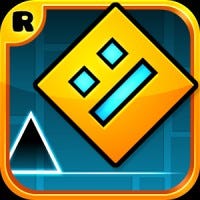
Featured Blog | This community-written post highlights the best of what the game industry has to offer. Read more like it on the Game Developer Blogs or learn how to Submit Your Own Blog Post
Prioritize players and their experience to succeed in gaming
Here are 5 things I learned that went into Geometry Dash and led to its success with nearly 80M downloads.

I never knew I’d be able to build mobile games full time. It started off as a fun project on the side. My first game, “Bounce ball thingy” was built around 3 years ago on a terrible PC laptop while I was studying to be a civil engineer. I had never worked on a game before that, and I only had rudimentary coding ability. Still, I had fun building the game, and mobile was really taking off, so it seemed like it could be a fun side project that might even get me a little spending money.
Next I made a few small puzzle games. They attracted hundreds of thousands of downloads, but I made some mistakes monetizing them, so they didn’t make much money or keep users coming back.
I took all my learnings into consideration when I made Geometry Dash. Now the game has been downloaded nearly 80 million times, and I’m able to work on it as my full time job. Here are 5 things I learned that went into Geometry Dash and led to its success:
Make what you know
From the moment I first fired up Super Mario Brothers on my NES, I have always had a love for platform games. The amount of variation and versatility you find is incredible. As a gamer, I would often play through my favorite platformers, like The Impossible Game, while keeping an eye out for what I would do differently. When you’re working on something you sincerely enjoy and know well, innovation will come more naturally.
Trust your community
What stands out to me most about Geometry Dash’s success is the community that it’s attracted. Ever since its initial release, the game has been iterated upon constantly as the community expanded and evolved. Part of this is due to a feature that lets users build their own levels—I create the tools so that users are empowered to do whatever they want with them. This meant I was constantly getting amazing feedback from the people playing my game; it’s honestly as much their game as it is mine.
Never stop innovating
I built Geometry Dash in about four months part-time but have since spent a lot more time adding levels, creating new content and trying out new things. The size of the game has more than doubled as the community grew, and more and more levels kept getting added. Innovation is essential, because I know that any new feature I add will be applied in a million different ways that I hadn’t even thought of by my users. It’s about more than maintaining a sense of novelty. It’s about creating opportunities for you and your users to build on each other’s creativity.
Focus on pleasing your users, not monetizing them
When I was making my smaller puzzle games early on, I made the mistake of hopping on the in-app purchases (IAP) bandwagon. Deploying and monetizing all of these features often means you end up spending more time building things to buy in your game than working on the game itself. Design ends up throttling your user experience. In Geometry Dash the user has full access to all features right from the start, and it's worked out great.
Today, I monetize with a paid version and some ads in the free version. I’ve found good success monetizing my free version with AppLovin. There’s a lot of ad solutions out there, but they’ve been the most responsive, transparent and ultimately made me the most money with advertising in the free version. I also use AdMob for banner ads and Chartboost, but just to cross-promote between the paid and free versions.
Make a better version of your game for your best customers
When it came to monetization, I found it helpful to think of the game as having two versions—a free version and a “pay once, never pay again” version. This has a lot of great effects, not the least of which is that it’s easier to maintain your rank if you’re a paid app instead of a free one. This approach lets me focus on creating a fun game that will keep players coming back instead of spending time thinking of new in-app purchases to generate money.
Every game designer walks a fine line. On one hand, you want to create something simple that anyone can pick up and play. On the other hand, if the game is too simple, then your most loyal players will get bored quickly and leave. The best way to monetize those users is not by selling them dubious features that do little to change the game. Instead, you need to focus on the player experience and what your players want.
Read more about:
Featured BlogsAbout the Author(s)
You May Also Like







.jpeg?width=700&auto=webp&quality=80&disable=upscale)








